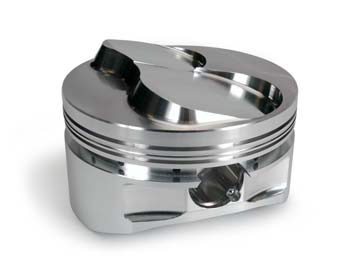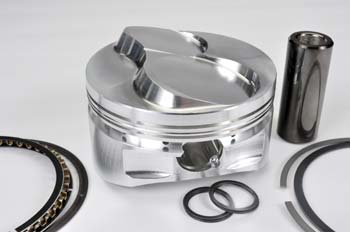NEW HIGH-COMPRESSION DOMED PISTONS FROM DIAMOND
Thu, 2008-05-29 10:00
New high-compression domed pistons for Trick Flow Twisted Wedge cylinder heads for the Ford Windsor
 Diamond
Pistons is launching a new domed series of pistons designed to
complement the Trick Flow Twisted Wedge cylinder head as applied to
higher compression Windsor 5.0 and 351 (5.7 liter) 90-degree
small-block Ford engines.
Diamond
Pistons is launching a new domed series of pistons designed to
complement the Trick Flow Twisted Wedge cylinder head as applied to
higher compression Windsor 5.0 and 351 (5.7 liter) 90-degree
small-block Ford engines.
The advantages of Trick Flow’s Twisted Wedge cylinder heads are significant. Rotating the valve arrangement (in clock rotation within the combustion chamber)—in contrast with the conventional inline configuration—allowed Trick Flow to increase the diameter of the inlet valve from 1.900 inches to 2.020 inches. Further, the air flow was improved by reconfiguring the inlet ports and all of this without requiring a change of pistons. Of course, if one has the desire to upgrade the pistons, such as these new high-compression types, then more advantages can be realized. New high-compression domed pistons for Trick Flow Twisted Wedge cylinder heads for the Ford Windsor
 Diamond Pistons is launching a new domed series of pistons designed to complement the Trick Flow Twisted Wedge cylinder head as applied to higher compression Windsor 5.0 and 351 (5.7 liter) 90-degree small-block Ford engines.
Diamond Pistons is launching a new domed series of pistons designed to complement the Trick Flow Twisted Wedge cylinder head as applied to higher compression Windsor 5.0 and 351 (5.7 liter) 90-degree small-block Ford engines.
The advantages of Trick Flow’s Twisted Wedge cylinder heads are significant. Rotating the valve arrangement (in clock rotation within the combustion chamber)—in contrast with the conventional inline configuration—allowed Trick Flow to increase the diameter of the inlet valve from 1.900 inches to 2.020 inches. Further, the air flow was improved by reconfiguring the inlet ports and all of this without requiring a change of pistons. Of course, if one has the desire to upgrade the pistons, such as these new high-compression types, then more advantages can be realized.
Forged from 2618 alloy, these pistons are developed for the week-end warriors and budget bracket racers, seeking higher compression ratios in either naturally aspirated engines or with nitrous oxide. They use a conventional ring stack (1/16 top, 1/16 second, and 3/16 oil). For naturally aspirated engines, the Total Seal Plasma Moly top ring is recommended. To combat the higher temperatures and cylinder pressures of nitrous injection, Diamond specifies Total Seal’s AP (Advanced Profile) stainless top ring that features a chrome nitride anti-friction face coating.
 The top ring is positioned sufficiently far down from the piston crown to protect it from excessive heat—this also allows for a generous thickness of material over the crown. As a result, these domed pistons can safely accommodate a 150-200 horsepower shot of nitrous oxide. Between the first and second rings, Diamond incorporates a pressure balance groove. This thin, V-shaped area becomes a reservoir that dissipates unwanted pressure between the rings, thus preventing it from unloading the ring, breaching the ring seal, and losing power.
The top ring is positioned sufficiently far down from the piston crown to protect it from excessive heat—this also allows for a generous thickness of material over the crown. As a result, these domed pistons can safely accommodate a 150-200 horsepower shot of nitrous oxide. Between the first and second rings, Diamond incorporates a pressure balance groove. This thin, V-shaped area becomes a reservoir that dissipates unwanted pressure between the rings, thus preventing it from unloading the ring, breaching the ring seal, and losing power.
Normally, the pistons are supplied with 4130 wrist pins and spiral locks. However, an upgraded H13 Tool Steel option is also available. Concurrently, the piston features double oiling ports in each wrist pin bore that are force-fed from the oil control ring groove. On long stroke models, where the wrist pin intersects the oil control ring groove, oil ring support rails are supplied.
Now available as shelf-stock items, these pistons are made to suit a 3.400-inch stroke with a 5.400-inch connecting rod, the most common connecting rod size or stroker combination in the aftermarket. For comparison, the 5.0 (302 CID) OE stroke is 3.00-inches with a 5.090-inch connecting rod. Bore over-sizes for the 302 and 351 are as follows: 0.030, 0.035, 0.040, and 0.060-inch. A further oversize of 0.125-inch is available for the 302 engine.
For more information, visit www.DiamondRacing.net .
 Diamond
Pistons is launching a new domed series of pistons designed to
complement the Trick Flow Twisted Wedge cylinder head as applied to
higher compression Windsor 5.0 and 351 (5.7 liter) 90-degree
small-block Ford engines.
Diamond
Pistons is launching a new domed series of pistons designed to
complement the Trick Flow Twisted Wedge cylinder head as applied to
higher compression Windsor 5.0 and 351 (5.7 liter) 90-degree
small-block Ford engines. The advantages of Trick Flow’s Twisted Wedge cylinder heads are significant. Rotating the valve arrangement (in clock rotation within the combustion chamber)—in contrast with the conventional inline configuration—allowed Trick Flow to increase the diameter of the inlet valve from 1.900 inches to 2.020 inches. Further, the air flow was improved by reconfiguring the inlet ports and all of this without requiring a change of pistons. Of course, if one has the desire to upgrade the pistons, such as these new high-compression types, then more advantages can be realized. New high-compression domed pistons for Trick Flow Twisted Wedge cylinder heads for the Ford Windsor
 Diamond Pistons is launching a new domed series of pistons designed to complement the Trick Flow Twisted Wedge cylinder head as applied to higher compression Windsor 5.0 and 351 (5.7 liter) 90-degree small-block Ford engines.
Diamond Pistons is launching a new domed series of pistons designed to complement the Trick Flow Twisted Wedge cylinder head as applied to higher compression Windsor 5.0 and 351 (5.7 liter) 90-degree small-block Ford engines. The advantages of Trick Flow’s Twisted Wedge cylinder heads are significant. Rotating the valve arrangement (in clock rotation within the combustion chamber)—in contrast with the conventional inline configuration—allowed Trick Flow to increase the diameter of the inlet valve from 1.900 inches to 2.020 inches. Further, the air flow was improved by reconfiguring the inlet ports and all of this without requiring a change of pistons. Of course, if one has the desire to upgrade the pistons, such as these new high-compression types, then more advantages can be realized.
Forged from 2618 alloy, these pistons are developed for the week-end warriors and budget bracket racers, seeking higher compression ratios in either naturally aspirated engines or with nitrous oxide. They use a conventional ring stack (1/16 top, 1/16 second, and 3/16 oil). For naturally aspirated engines, the Total Seal Plasma Moly top ring is recommended. To combat the higher temperatures and cylinder pressures of nitrous injection, Diamond specifies Total Seal’s AP (Advanced Profile) stainless top ring that features a chrome nitride anti-friction face coating.
 The top ring is positioned sufficiently far down from the piston crown to protect it from excessive heat—this also allows for a generous thickness of material over the crown. As a result, these domed pistons can safely accommodate a 150-200 horsepower shot of nitrous oxide. Between the first and second rings, Diamond incorporates a pressure balance groove. This thin, V-shaped area becomes a reservoir that dissipates unwanted pressure between the rings, thus preventing it from unloading the ring, breaching the ring seal, and losing power.
The top ring is positioned sufficiently far down from the piston crown to protect it from excessive heat—this also allows for a generous thickness of material over the crown. As a result, these domed pistons can safely accommodate a 150-200 horsepower shot of nitrous oxide. Between the first and second rings, Diamond incorporates a pressure balance groove. This thin, V-shaped area becomes a reservoir that dissipates unwanted pressure between the rings, thus preventing it from unloading the ring, breaching the ring seal, and losing power.Normally, the pistons are supplied with 4130 wrist pins and spiral locks. However, an upgraded H13 Tool Steel option is also available. Concurrently, the piston features double oiling ports in each wrist pin bore that are force-fed from the oil control ring groove. On long stroke models, where the wrist pin intersects the oil control ring groove, oil ring support rails are supplied.
Now available as shelf-stock items, these pistons are made to suit a 3.400-inch stroke with a 5.400-inch connecting rod, the most common connecting rod size or stroker combination in the aftermarket. For comparison, the 5.0 (302 CID) OE stroke is 3.00-inches with a 5.090-inch connecting rod. Bore over-sizes for the 302 and 351 are as follows: 0.030, 0.035, 0.040, and 0.060-inch. A further oversize of 0.125-inch is available for the 302 engine.
For more information, visit www.DiamondRacing.net .
Categories:




































